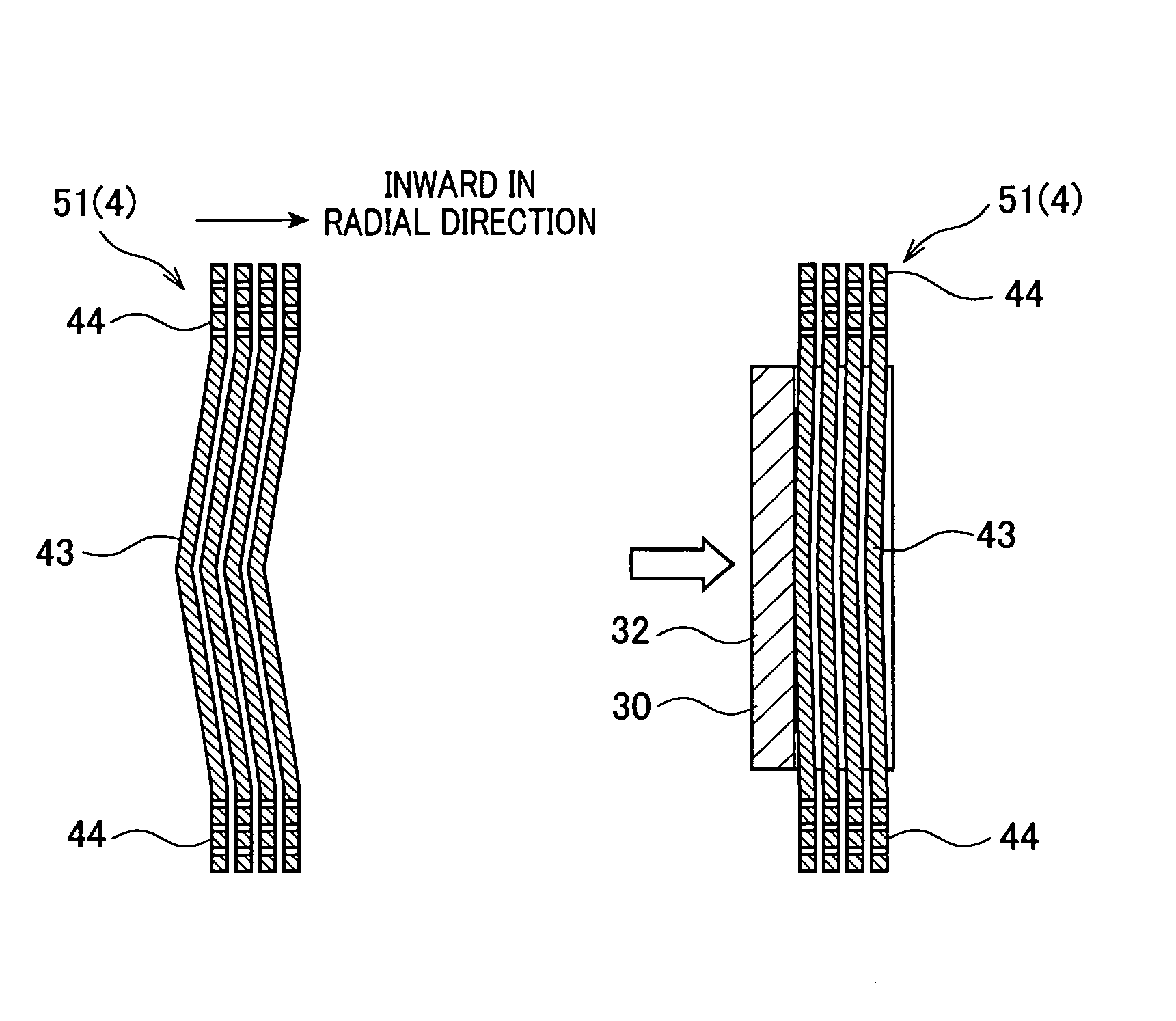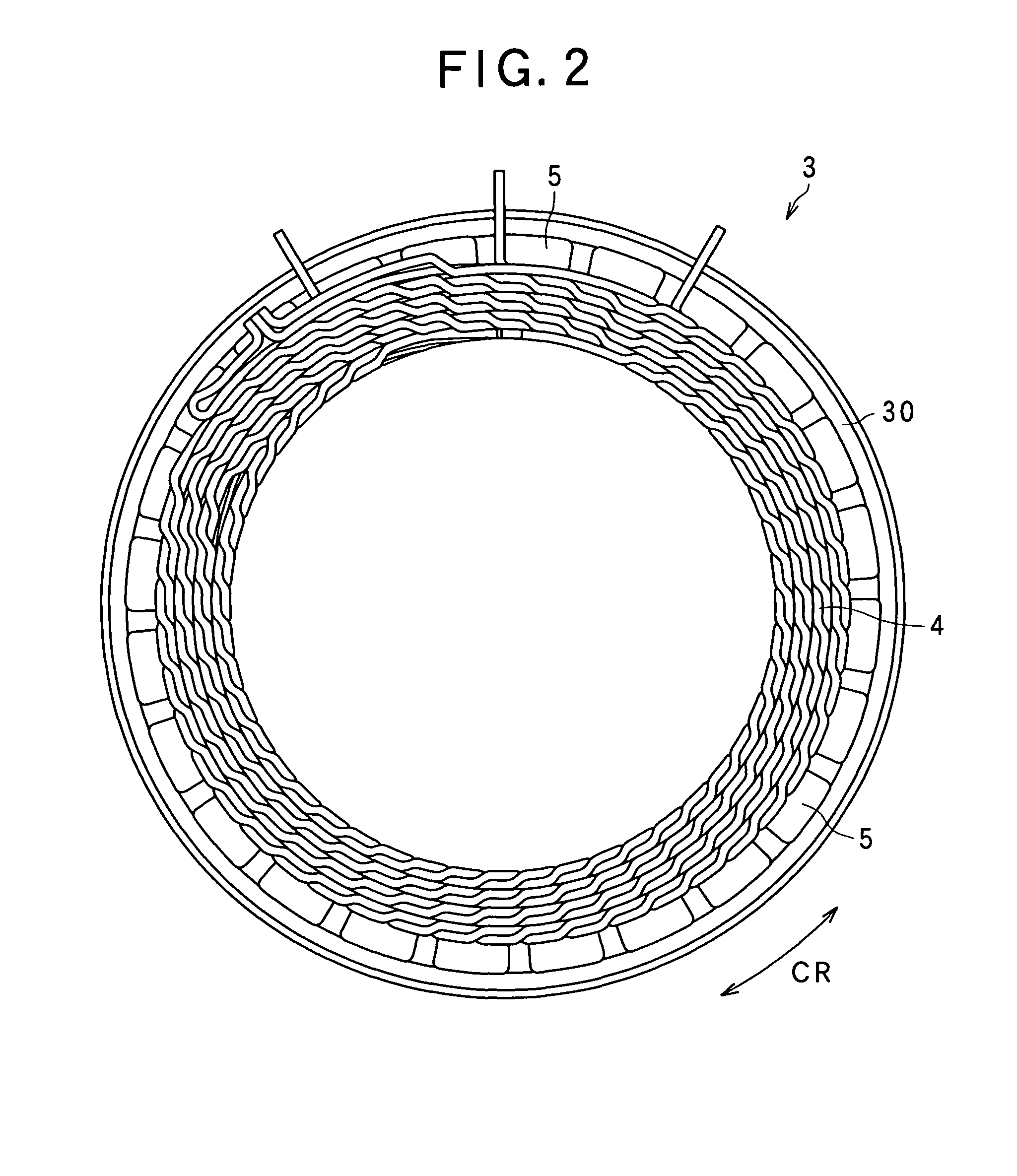Stator for rotary electric machine and method of manufacturing the stator
a technology of rotary electric machines and stator coils, which is applied in the direction of magnets, magnetic circuit shapes/forms/construction, magnetic bodies, etc., can solve the problems of stator coils protruding, electric short circuits, and difficult deformation, and achieve convenient deformation, easy deformation, and convenient deformation.
- Summary
- Abstract
- Description
- Claims
- Application Information
AI Technical Summary
Benefits of technology
Problems solved by technology
Method used
Image
Examples
first embodiment
First of all, the configuration of a rotary electric machine which uses the stator of the rotary electric machine according to the present embodiment will now be described. As shown in FIG. 1, this electric machine 1 comprises a housing composed of a pair of housing members 100 and 101 each of which is shaped into an approximately cylindrical shape with a bottom and an opening, wherein the respective openings of both housing members being connected to each other, a rotary shaft 20 rotatably supported by bearings 110 and 111 secured to the housing 10, a rotor 2 secured to the rotary shaft 20, and a stator 3 secured to the housing 10 so that the stator is positioned to enclose the rotor 2 within the housing 10.
In the present embodiment, the longitudinal direction of the rotary shaft 20 is defined as an axial direction(s) AX, the directions radially extending from the rotary shaft 20 along a plane perpendicular to the axial direction AX is defined as a radial direction(s) RA, and the d...
second embodiment
Referring to FIGS. 11A and 11B, a stator 3 according to the second embodiment will now be described. In the present and subsequent embodiments, the components identical or similar to those described in the first embodiment are given the same reference numerals for the sake of simplified or omitted description.
The stator 3 according to the second embodiment differs from that in the previous embodiment in the shape of a stator coil 140 provided in the state prior to being assembled with the stator core 30. As shown in FIG. 11A, where the stator coil 140 provided with slot accommodation portions 143 and coil end portions 44 is provided. Each of the slot accommodation portions 143 has a connection portion integrally formed with one of both coil end portions 44 and the connection portion is formed to have a tangent line which is substantially parallel to the axial line AX of the stator coil 4. In other words, each slot accommodation portion 143 is gradually bent from both axial ends of t...
third embodiment
Referring to FIGS. 12A and 12B, a stator 3 according to the third embodiment will now be described.
The stator 3 according to the third embodiment differs from that in the previous embodiments in the shape of a stator coil 240 provided in the state prior to being assembled with the stator core 30. The stator coils 4 and 140 explained in the first and second embodiments are given the axial central parts each having a pointed top. In contrast, in the present embodiment, as shown in FIG. 12A, a stator coil 240 has stator coils 240 given slot accommodation portions 243 and each of the slot accommodation portions 243 is bent in the same way as the foregoing, but to have a smoothly bent round top. That is, the whole segment of each of the slot accommodation portions 243 is curved. As a result, as shown in FIG. 12B, when the slot-accommodated portions 243 are pressed by the stator core 30, a substantial area contact can be achieved between the stator core 30 and the slot-accommodated portio...
PUM
| Property | Measurement | Unit |
|---|---|---|
| thickness | aaaaa | aaaaa |
| thickness | aaaaa | aaaaa |
| thickness | aaaaa | aaaaa |
Abstract
Description
Claims
Application Information
 Login to View More
Login to View More - R&D
- Intellectual Property
- Life Sciences
- Materials
- Tech Scout
- Unparalleled Data Quality
- Higher Quality Content
- 60% Fewer Hallucinations
Browse by: Latest US Patents, China's latest patents, Technical Efficacy Thesaurus, Application Domain, Technology Topic, Popular Technical Reports.
© 2025 PatSnap. All rights reserved.Legal|Privacy policy|Modern Slavery Act Transparency Statement|Sitemap|About US| Contact US: help@patsnap.com



